2016 NISSAN VERSA SEDAN phone
[x] Cancel search: phonePage 265 of 386

1. Apply the parking brake.
2. Move the shift lever to P (Park) or N (Neu-tral) . P (Park) is recommended.
The starter is designed not to operate if
the shift lever is in any of the driving
positions.
3. Push the ignition switch to the ON position. Depress the brake pedal and push the igni-
tion switch to start the engine.
To start the engine immediately, push and
release the ignition switch while depressing
the brake pedal with the ignition switch in
any position.
● If the engine is very hard to start in ex-
tremely cold weather or when restarting,
depress the accelerator pedal a little (ap-
proximately 1/3 to the floor) and while
holding, crank the engine. Release the
accelerator pedal when the engine starts.
● If the engine is very hard to start because
it is flooded, depress the accelerator
pedal all the way to the floor and hold it.
Push the ignition switch to the ON posi-
tion to start cranking the engine. After five
or six seconds, stop cranking by pushing
the ignition switch to LOCK. After crank-
ing the engine, release the accelerator
pedal. Crank the engine with your foot off the accelerator pedal by depressing the
brake pedal and pushing the push-button
ignition switch to start the engine. If the
engine starts, but fails to run, repeat the
above procedure.
CAUTION
Do not operate the starter for more than
15 seconds at a time. If the engine does
not start, push the ignition switch to the
OFF position and wait 10 seconds before
cranking again, otherwise the starter
could be damaged.
4. Warm-up
Allow the engine to idle for at least 30 sec-
onds after starting. Do not race the engine
while warming it up. Drive at moderate
speed for a short distance first, especially in
cold weather. In cold weather, keep the en-
gine running for a minimum of two to three
minutes before shutting it off. Starting and
stopping the engine over a short period of
time may make the vehicle more difficult to
start.
5. To stop the engine, shift the shift lever into the P (Park) position and push the ignition
switch to the OFF position. NOTE:
Care should be taken to avoid situations
that can lead to potential battery discharge
and potential no-start conditions such as:
1. Installation or extended use of electronic accessories that consume battery power
when the engine is not running (Phone char-
gers, GPS, DVD players, etc.)
2. Vehicle is not driven regularly and/or only driven short distances. In these cases, the
battery may need to be charged to maintain
battery health.
STARTING THE ENGINE (models with
NISSAN Intelligent Key® system)
5-16Starting and driving
Page 315 of 386
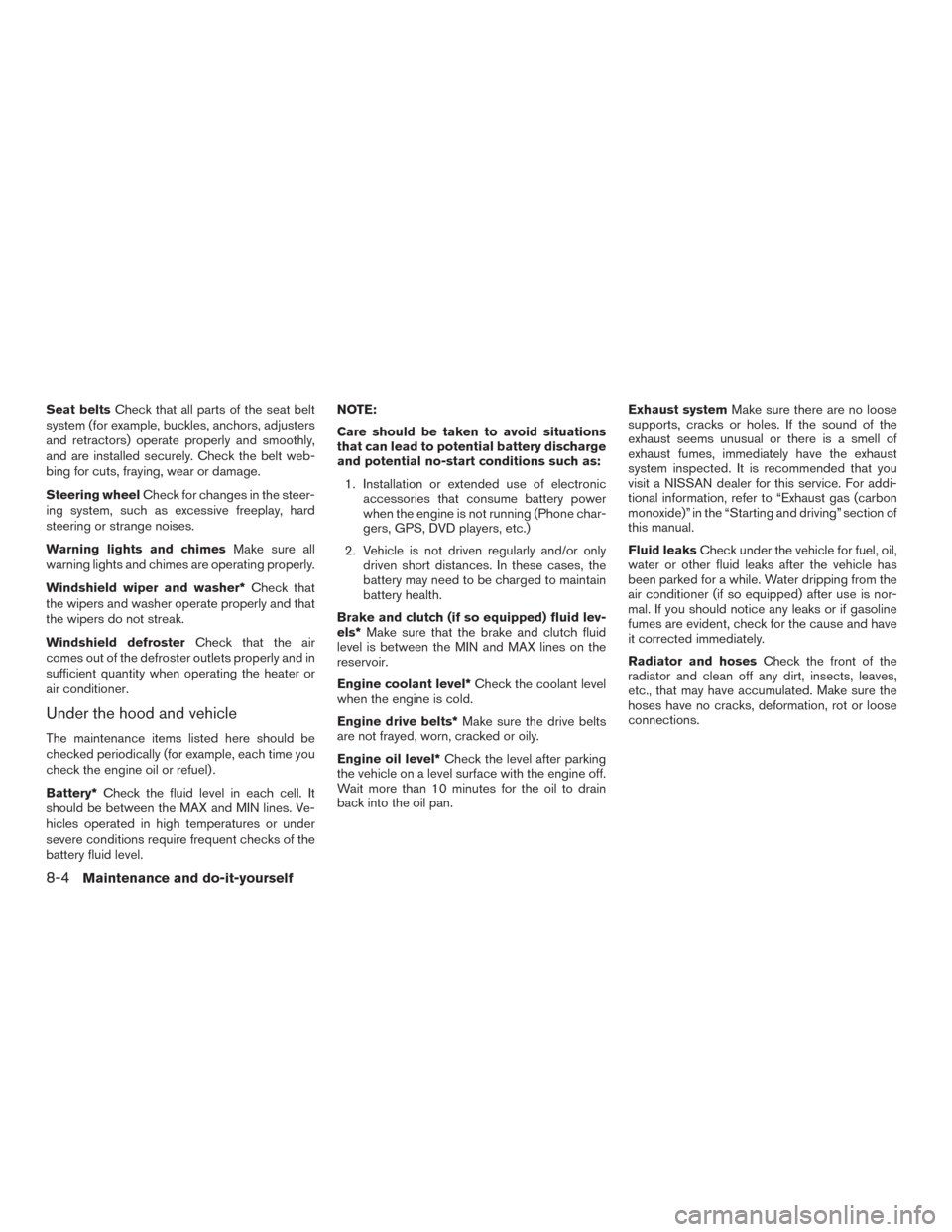
Seat beltsCheck that all parts of the seat belt
system (for example, buckles, anchors, adjusters
and retractors) operate properly and smoothly,
and are installed securely. Check the belt web-
bing for cuts, fraying, wear or damage.
Steering wheel Check for changes in the steer-
ing system, such as excessive freeplay, hard
steering or strange noises.
Warning lights and chimes Make sure all
warning lights and chimes are operating properly.
Windshield wiper and washer* Check that
the wipers and washer operate properly and that
the wipers do not streak.
Windshield defroster Check that the air
comes out of the defroster outlets properly and in
sufficient quantity when operating the heater or
air conditioner.
Under the hood and vehicle
The maintenance items listed here should be
checked periodically (for example, each time you
check the engine oil or refuel) .
Battery* Check the fluid level in each cell. It
should be between the MAX and MIN lines. Ve-
hicles operated in high temperatures or under
severe conditions require frequent checks of the
battery fluid level. NOTE:
Care should be taken to avoid situations
that can lead to potential battery discharge
and potential no-start conditions such as:
1. Installation or extended use of electronic accessories that consume battery power
when the engine is not running (Phone char-
gers, GPS, DVD players, etc.)
2. Vehicle is not driven regularly and/or only driven short distances. In these cases, the
battery may need to be charged to maintain
battery health.
Brake and clutch (if so equipped) fluid lev-
els* Make sure that the brake and clutch fluid
level is between the MIN and MAX lines on the
reservoir.
Engine coolant level* Check the coolant level
when the engine is cold.
Engine drive belts* Make sure the drive belts
are not frayed, worn, cracked or oily.
Engine oil level* Check the level after parking
the vehicle on a level surface with the engine off.
Wait more than 10 minutes for the oil to drain
back into the oil pan. Exhaust system
Make sure there are no loose
supports, cracks or holes. If the sound of the
exhaust seems unusual or there is a smell of
exhaust fumes, immediately have the exhaust
system inspected. It is recommended that you
visit a NISSAN dealer for this service. For addi-
tional information, refer to “Exhaust gas (carbon
monoxide)” in the “Starting and driving” section of
this manual.
Fluid leaks Check under the vehicle for fuel, oil,
water or other fluid leaks after the vehicle has
been parked for a while. Water dripping from the
air conditioner (if so equipped) after use is nor-
mal. If you should notice any leaks or if gasoline
fumes are evident, check for the cause and have
it corrected immediately.
Radiator and hoses Check the front of the
radiator and clean off any dirt, insects, leaves,
etc., that may have accumulated. Make sure the
hoses have no cracks, deformation, rot or loose
connections.
8-4Maintenance and do-it-yourself
Page 326 of 386
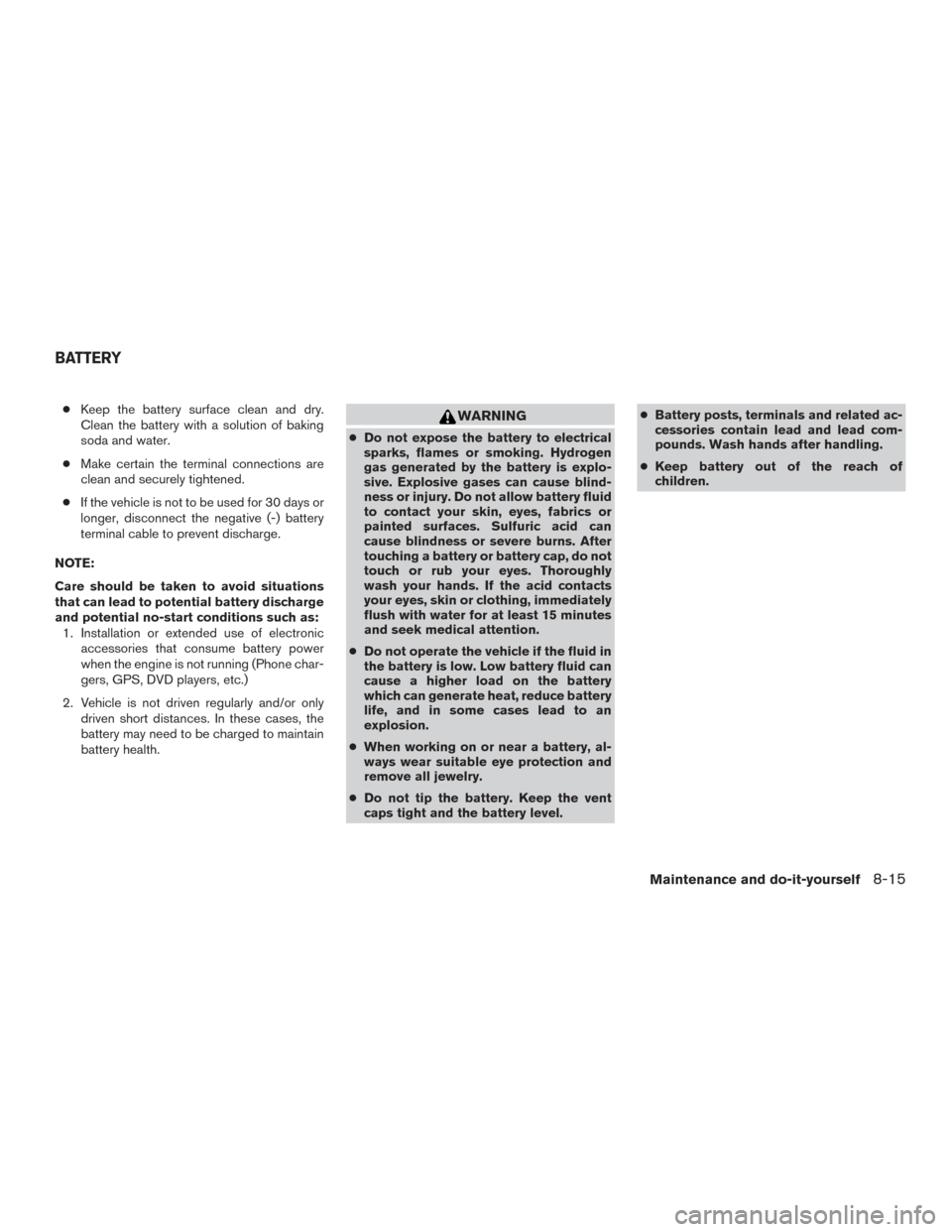
●Keep the battery surface clean and dry.
Clean the battery with a solution of baking
soda and water.
● Make certain the terminal connections are
clean and securely tightened.
● If the vehicle is not to be used for 30 days or
longer, disconnect the negative (-) battery
terminal cable to prevent discharge.
NOTE:
Care should be taken to avoid situations
that can lead to potential battery discharge
and potential no-start conditions such as: 1. Installation or extended use of electronic accessories that consume battery power
when the engine is not running (Phone char-
gers, GPS, DVD players, etc.)
2. Vehicle is not driven regularly and/or only driven short distances. In these cases, the
battery may need to be charged to maintain
battery health.WARNING
●Do not expose the battery to electrical
sparks, flames or smoking. Hydrogen
gas generated by the battery is explo-
sive. Explosive gases can cause blind-
ness or injury. Do not allow battery fluid
to contact your skin, eyes, fabrics or
painted surfaces. Sulfuric acid can
cause blindness or severe burns. After
touching a battery or battery cap, do not
touch or rub your eyes. Thoroughly
wash your hands. If the acid contacts
your eyes, skin or clothing, immediately
flush with water for at least 15 minutes
and seek medical attention.
● Do not operate the vehicle if the fluid in
the battery is low. Low battery fluid can
cause a higher load on the battery
which can generate heat, reduce battery
life, and in some cases lead to an
explosion.
● When working on or near a battery, al-
ways wear suitable eye protection and
remove all jewelry.
● Do not tip the battery. Keep the vent
caps tight and the battery level. ●
Battery posts, terminals and related ac-
cessories contain lead and lead com-
pounds. Wash hands after handling.
● Keep battery out of the reach of
children.
BATTERY
Maintenance and do-it-yourself8-15
Page 376 of 386

Genuine NISSAN Service Manuals for this model
year and prior can be purchased. A Genuine
NISSAN Service Manual is the best source of
service and repair information for your vehicle.
This manual is the same one used by the factory-
trained technicians working at NISSAN dealer-
ships. Genuine NISSAN Owner’s Manuals can
also be purchased.
For USA
For current pricing and availability of Genuine
NISSAN Service Manuals,contact:
www.nissan-techinfo.com
For current pricing and availability of Genuine
NISSAN Owner’s Manuals, contact:
1-800-247-5321
For Canada
To purchase a copy of a Genuine NISSAN Ser-
vice Manual or Owner’s Manual, for this model
year and prior, please contact your nearest
NISSAN dealer. For the phone number and loca-
tion of a NISSAN dealer in your area, call the
NISSAN Information Center at 1-800-387-0122
and a bilingual NISSAN representative will assist
you.
OWNER’S MANUAL/SERVICE
MANUAL ORDER INFORMATION
Technical and consumer information9-21
Page 378 of 386
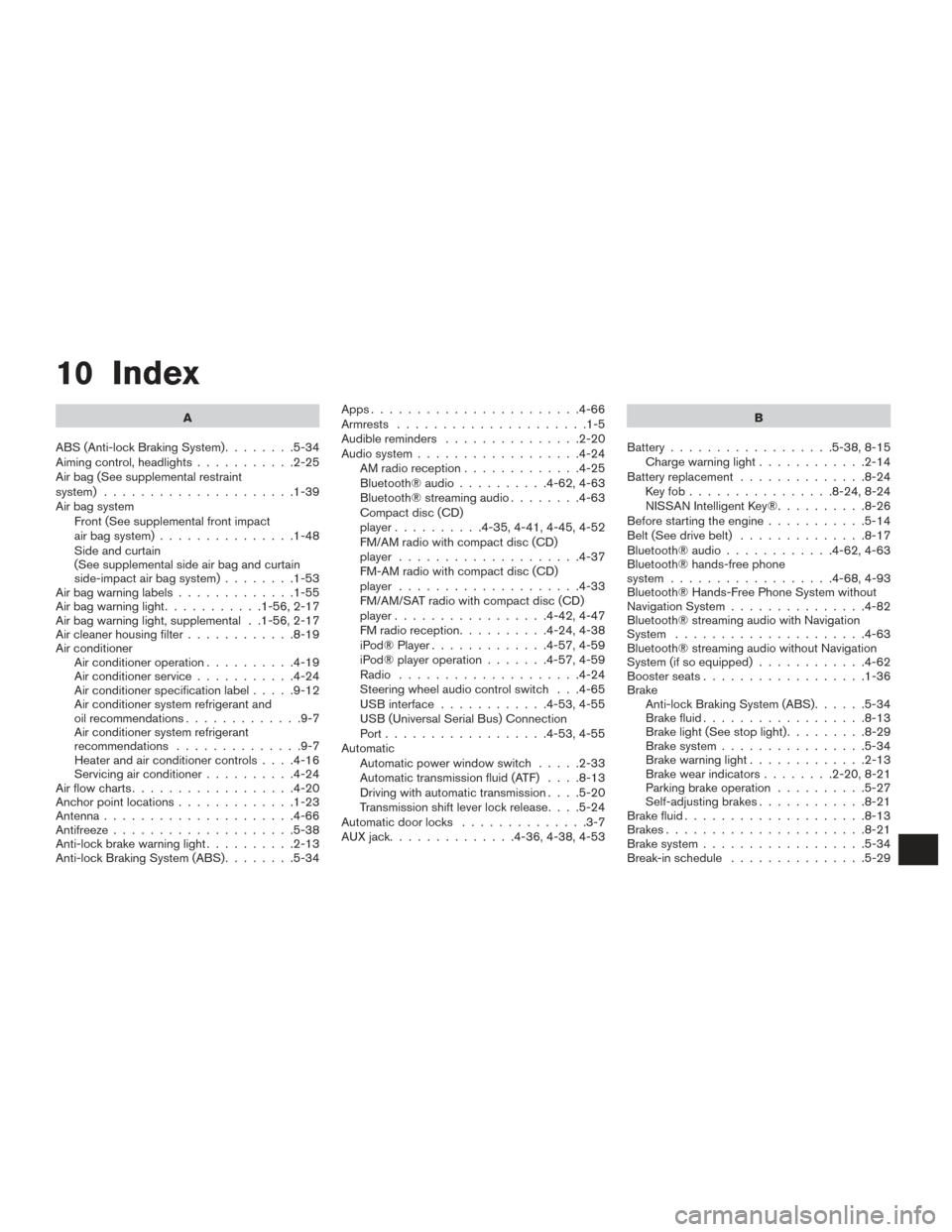
10 Index
A
ABS (Anti-lock Braking System) ........5-34
Aiming control, headlights ...........2-25
Air bag (See supplemental restraint
system) .....................1-39
Air bag system Front (See supplemental front impact
air bag system) ...............1-48
Side and curtain
(See supplemental side air bag and curtain
side-impact air bag system) ........1-53
Airbagwarninglabels.............1-55
Airbagwarninglight...........1-56,2-17
Air bag warning light, supplemental . .1-56, 2-17
Air cleaner housing filter ............8-19
Air conditioner Air conditioner operation ..........4-19
Air conditioner service ...........4-24
Air conditioner specification label .....9-12
Air conditioner system refrigerant and
oil recommendations .............9-7
Air conditioner system refrigerant
recommendations ..............9-7
Heater and air conditioner controls ....4-16
Servicing air conditioner ..........4-24
Airflowcharts..................4-20
Anchor point locations .............1-23
Antenna .....................4-66
Antifreeze ....................5-38
Anti-lock brake warning light ..........2-13
Anti-lock Braking System (ABS) ........5-34Apps
.......................4-66
Armrests .....................1-5
Audible reminders ...............2-20
Audio system ..................4-24
AMradioreception.............4-25
Bluetooth®audio..........4-62,4-63
Bluetooth® streaming audio ........4-63
Compact disc (CD)
player..........4-35,4-41,4-45,4-52
FM/AM radio with compact disc (CD)
player ....................4-37
FM-AM radio with compact disc (CD)
player ....................4-33
FM/AM/SAT radio with compact disc (CD)
player.................4-42,4-47
FMradioreception..........4-24,4-38
iPod® Player .............4-57,4-59
iPod® player operation .......4-57,4-59
Radio ....................4-24
Steering wheel audio control switch . . .4-65
USB interface ............4-53,4-55
USB (Universal Serial Bus) Connection
Port..................4-53,4-55
Automatic Automatic power window switch .....2-33
Automatic transmission fluid (ATF) ....8-13
Driving with automatic transmission ....5-20
Transmission shift lever lock release ....5-24
Automatic door locks ..............3-7
AUXjack..............4-36,4-38,4-53 B
Battery ..................5-38, 8-15
Charge warning light ............2-14
Battery replacement ..............8-24
Keyfob................8-24,8-24
NISSAN Intelligent Key® ..........8-26
Before starting the engine ...........5-14
Belt (See drive belt) ..............8-17
Bluetooth® audio ............4-62,4-63
Bluetooth® hands-free phone
system..................4-68,4-93
Bluetooth® Hands-Free Phone System without
Navigation System ...............4-82
Bluetooth® streaming audio with Navigation
System .....................4-63
Bluetooth® streaming audio without Navigation
System (if so equipped) ............4-62
Boosterseats..................1-36
Brake Anti-lock Braking System (ABS) ......5-34
Brake fluid ..................8-13
Brakelight(Seestoplight).........8-29
Brake system ................5-34
Brakewarninglight.............2-13
Brakewearindicators........2-20,8-21
Parking brake operation ..........5-27
Self-adjusting brakes ............8-21
Brake fluid ....................8-13
Brakes ......................8-21
Brake system .................. 5
-34
Break-inschedule ...............5-29
Page 379 of 386
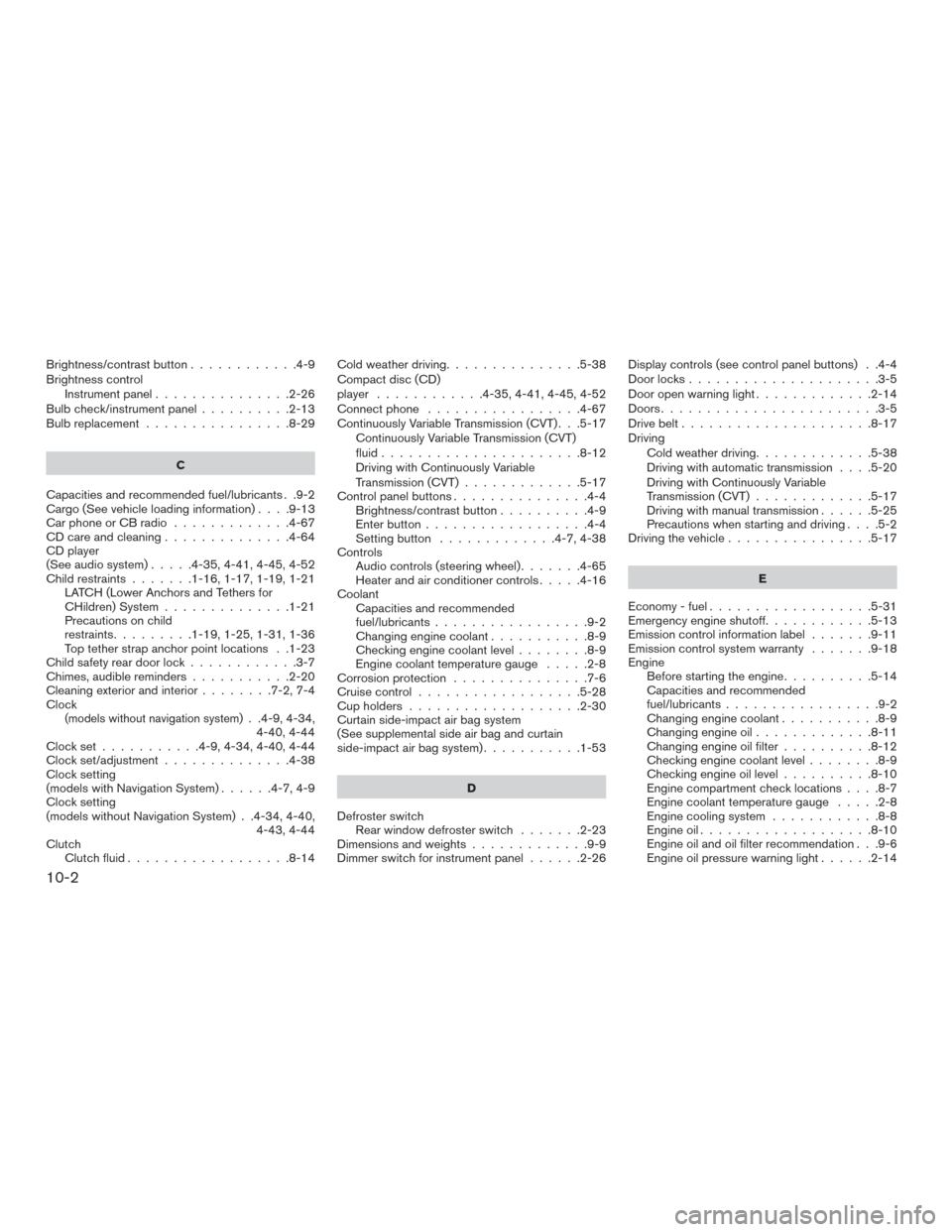
Brightness/contrastbutton............4-9
Brightness controlInstrument panel ...............2-26
Bulb check/instrument panel ..........2-13
Bulb replacement ................8-29
C
Capacities and recommended fuel/lubricants . .9-2
Cargo(Seevehicleloadinginformation)....9-13
Car phone or CB radio .............4-67
CD care and cleaning ..............4-64
CD player
(See audio system) .....4-35,4-41,4-45,4-52
Child restraints .......1-16,1-17,1-19,1-21
LATCH (Lower Anchors and Tethers for
CHildren) System ..............1-21
Precautions on child
restraints.........1-19,1-25,1-31,1-36
Top tether strap anchor point locations . .1-23
Child safety rear door lock ............3-7
Chimes, audible reminders ...........2-20
Cleaningexteriorandinterior........7-2,7-4
Clock
(models without navigation system). .4-9, 4-34, 4-40, 4-44
Clockset...........4-9,4-34,4-40,4-44
Clock set/adjustment ..............4-38
Clock setting
(models with Navigation System) ......4-7,4-9
Clock setting
(models without Navigation System) . .4-34, 4-40, 4-43, 4-44
Clutch Clutch fluid ..................8-14 Cold weather driving
...............5-38
Compact disc (CD)
player ............4-35,4-41,4-45,4-52
Connect phone .................4-67
Continuously Variable Transmission (CVT) . . .5-17 Continuously Variable Transmission (CVT)
fluid......................8-12
Driving with Continuously Variable
Transmission (CVT) .............5-17
Control panel buttons ...............4-4
Brightness/contrast button ..........4-9
Enterbutton..................4-4
Setting button .............4-7,4-38
Controls Audio controls (steering wheel) .......4-65
Heater and air conditioner controls .....4-16
Coolant Capacities and recommended
fuel/lubricants .................9-2
Changingenginecoolant...........8-9
Checking engine coolant level ........8-9
Engine coolant temperature gauge .....2-8
Corrosion protection ...............7-6
Cruisecontrol..................5-28
Cupholders...................2-30
Curtain side-impact air bag system
(See supplemental side air bag and curtain
side-impact air bag system) ...........1-53
D
Defroster switch Rear window defroster switch .......2-23
Dimensionsandweights.............9-9
Dimmer switch for instrument panel ......2-26Display controls (see control panel buttons) . .4-4
Door locks
.....................3-5
Door open warning light .............2-14
Doors ........................3-5
Drive belt .....................8-17
Driving Cold weather driving .............5-38
Driving with automatic transmission ....5-20
Driving with Continuously Variable
Transmission (CVT) .............5-17
Driving with manual transmission ......5-25
Precautions when starting and driving ....5-2
Driving the vehicle ................5-17
E
Economy-fuel..................5-31
Emergency engine shutoff ............5-13
Emission control information label .......9-11
Emission control system warranty .......9-18
Engine Before starting the engine ..........5-14
Capacities and recommended
fuel/lubricants.................9-2
Changing engine coolant ...........8-9
Changingengineoil.............8-11
Changing engine oil filter ..........8-12
Checking engine coolant level ........8-9
Checking engine oil level ..........8-10
Engine compartment check locations ....8-7
Engine coolant temperature gauge .....2-8
Engine cooling system ............8-8
Engineoil...................8-10
Engine oil and oil filter recommendation . . .9-6
Engine oil pressure warning light ......2-14
10-2
Page 380 of 386
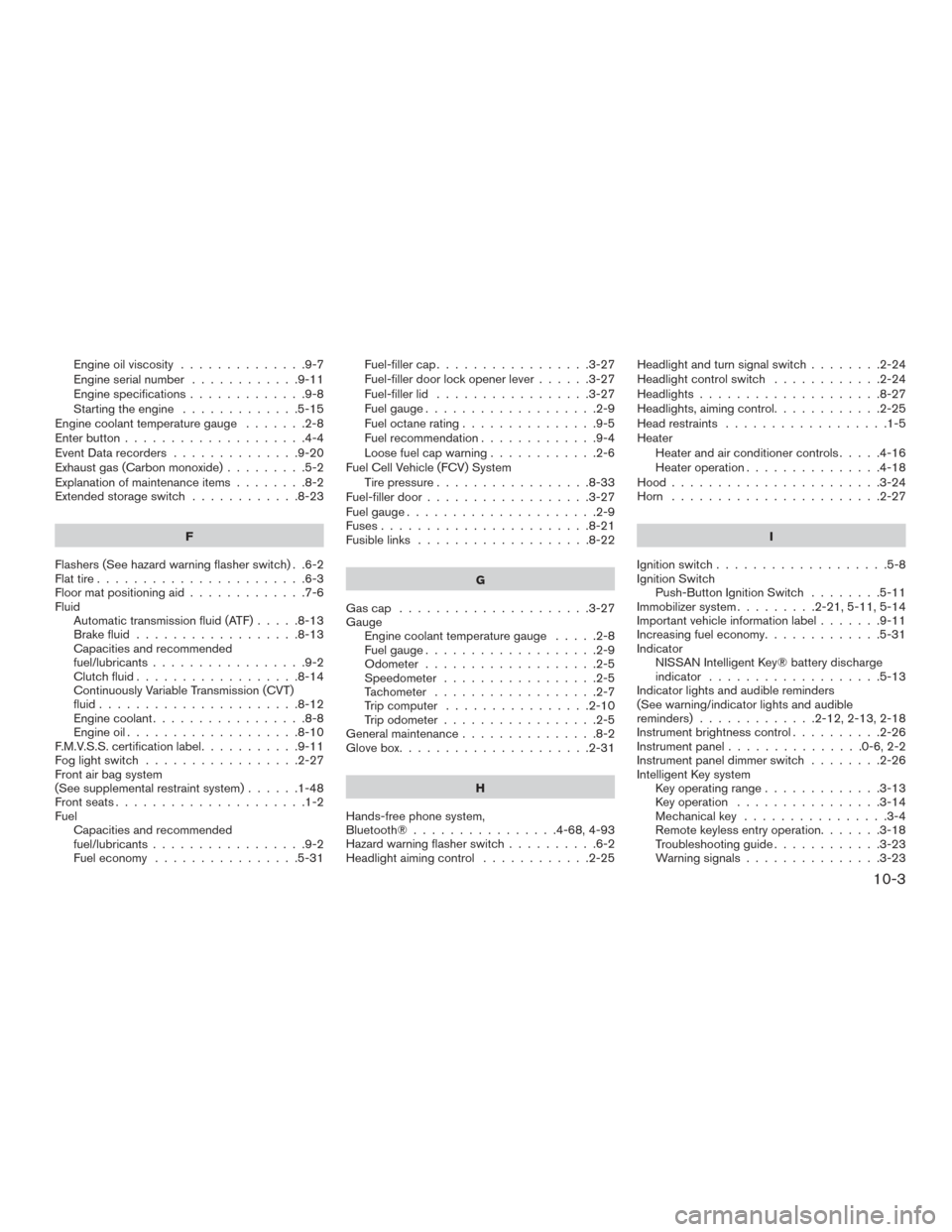
Engine oil viscosity..............9-7
Engine serial number ............9-11
Engine specifications .............9-8
Starting the engine .............5-15
Engine coolant temperature gauge .......2-8
Enterbutton....................4-4
Event Data recorders ..............9-20
Exhaust gas (Carbon monoxide) .........5-2
Explanation of maintenance items ........8-2
Extendedstorageswitch ............8-23
F
Flashers (See hazard warning flasher switch) . .6-2
Flat tire .......................6-3
Floor mat positioning aid .............7-6
Fluid Automatic transmission fluid (ATF) .....8-13
Brake fluid ..................8-13
Capacities and recommended
fuel/lubricants .................9-2
Clutchfluid..................8-14
Continuously Variable Transmission (CVT)
fluid......................8-12
Engine coolant .................8-8
Engine oil ...................8-10
F.M.V.S.S. certification label ...........9-11
Foglightswitch .................2-27
Front air bag system
(See supplemental restraint system) ......1-48
Frontseats.....................1-2
Fuel Capacities and recommended
fuel/lubricants .................9-2
Fuel economy ................5-31 Fuel-filler cap
.................3-27
Fuel-filler door lock opener lever ......3-27
Fuel-filler lid .................3-27
Fuel gauge ...................2-9
Fuel octane rating ...............9-5
Fuel recommendation .............9-4
Loose fuel cap warning ............2-6
Fuel Cell Vehicle (FCV) System Tirepressure.................8-33
Fuel-filler door ..................3-27
Fuelgauge.....................2-9
Fuses.......................8-21
Fusiblelinks ...................8-22
G
Gascap .....................3-27
Gauge Engine coolant temperature gauge .....2-8
Fuel gauge ...................2-9
Odometer ...................2-5
Speedometer .................2-5
Tachometer ..................2-7
Trip computer ................2-10
Trip odometer .................2-5
General maintenance ...............8-2
Glovebox.....................2-31
H
Hands-free phone system,
Bluetooth®................4-68,4-93
Hazard warning flasher switch ..........6-2
Headlight aiming control ............2-25 Headlightandturnsignalswitch........2-24
Headlightcontrolswitch ............2-24
Headlights....................8-27
Headlights, aiming control
............2-25
Head restraints ..................1-5
Heater Heater and air conditioner controls .....4-16
Heater operation ...............4-18
Hood.......................3-24
Horn .......................2-27
I
Ignition switch................... 5
-8
Ignition Switch Push-Button Ignition Switch ........5-11
Immobilizer system .........2-21,5-11,5-14
Important vehicle information label .......9-11
Increasing fuel economy .............5-31
Indicator NISSAN Intelligent Key® battery discharge
indicator ...................5-13
Indicator lights and audible reminders
(See warning/indicator lights and audible
reminders).............2-12,2-13,2-18
Instrument brightness control ..........2-26
Instrumentpanel...............0-6,2-2
Instrument panel dimmer switch ........2-26
Intelligent Key system Key operating range .............3-13
Key operation ................3-14
Mechanical key ................3-4
Remote keyless entry operation.......3-18
Troubleshooting guide ............3-23
Warning signals ...............3-23
10-3
Page 382 of 386
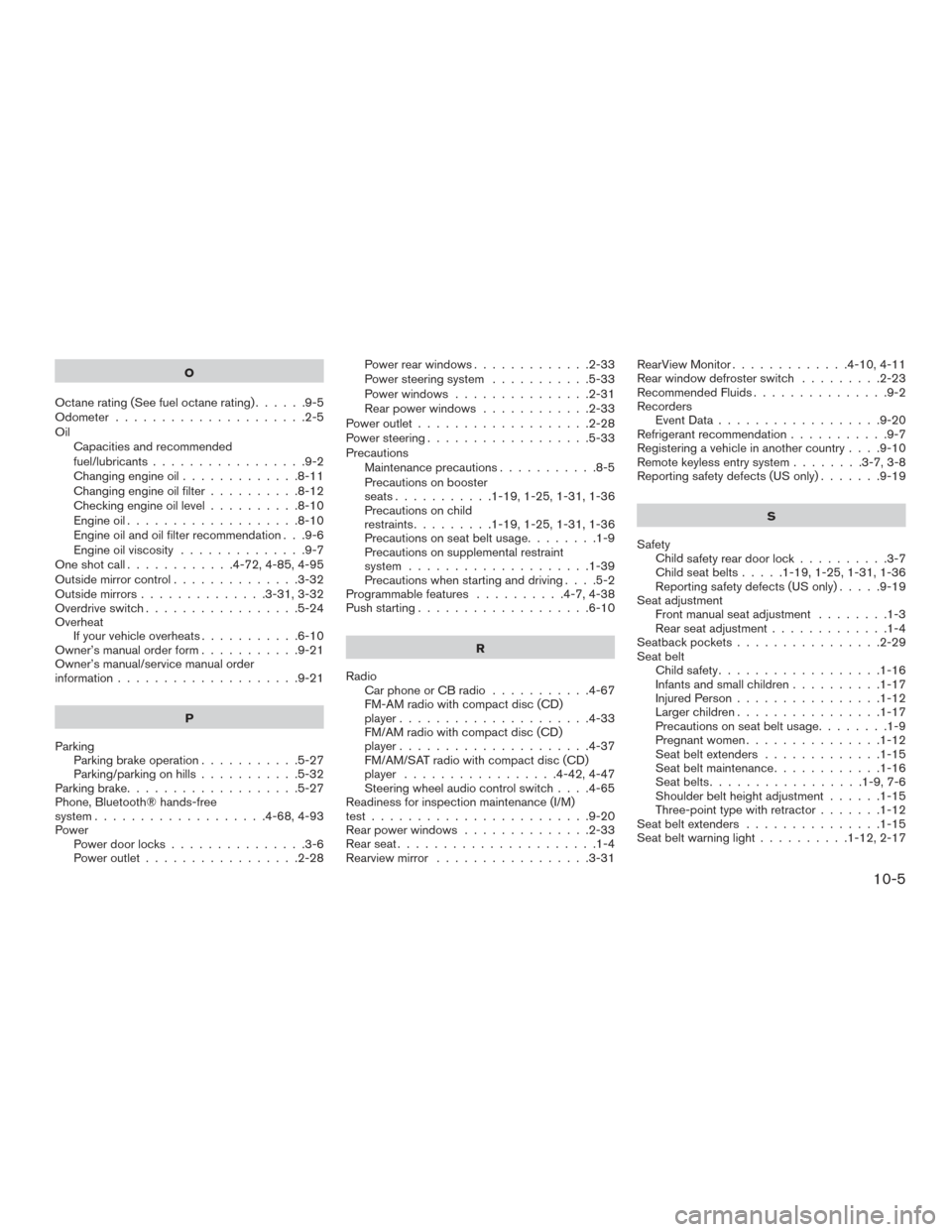
O
Octanerating(Seefueloctanerating)......9-5
Odometer .....................2-5
Oil Capacities and recommended
fuel/lubricants .................9-2
Changing engine oil .............8-11
Changing engine oil filter ..........8-12
Checking engine oil level ..........8-10
Engine oil ...................8-10
Engine oil and oil filter recommendation . . .9-6
Engine oil viscosity ..............9-7
Oneshotcall............4-72,4-85,4-95
Outside mirror control ..............3-32
Outside mirrors ..............3-31,3-32
Overdrive switch .................5-24
Overheat Ifyourvehicleoverheats...........6-10
Owner’s manual order form ...........9-21
Owner’s manual/service manual order
information ....................9-21
P
Parking Parking brake operation ...........5-27
Parking/parking on hills ...........5-32
Parking brake ...................5-27
Phone, Bluetooth® hands-free
system ...................4-68,4-93
Power Power door locks ...............3-6
Power outlet .................2-28 Power rear windows
.............2-33
Power steering system ...........5-33
Power windows ...............2-31
Rear power windows ............2-33
Power outlet ...................2-28
Power steering ..................5-33
Precautions Maintenance precautions ...........8-5
Precautions on booster
seats...........1-19,1-25,1-31,1-36
Precautions on child
restraints .........1-19,1-25,1-31,1-36
Precautions on seat belt usage ........1-9
Precautions on supplemental restraint
system ....................1-39
Precautions when starting and driving ....5-2
Programmablefeatures ..........4-7,4-38
Push starting ...................6-10
R
Radio Car phone or CB radio ...........4-67
FM-AM radio with compact disc (CD)
player .....................4-33
FM/AM radio with compact disc (CD)
player .....................4-37
FM/AM/SAT radio with compact disc (CD)
player .................4-42,4-47
Steering wheel audio control switch ....4-65
Readiness for inspection maintenance (I/M)
test........................9-20
Rear power windows ..............2-33
Rearseat......................1-4
Rearview mirror .................3-31 RearView Monitor
.............4-10,4-11
Rear window defroster switch .........2-23
Recommended Fluids ...............9-2
Recorders EventData..................9-20
Refrigerant recommendation ...........9-7
Registering a vehicle in another country ....9-10
Remote keyless entry system ........3-7,3-8
Reporting safety defects (US only) .......9-19
S
Safety Child safety rear
door lock ..........3-7
Child seat belts .....1-19,1-25,1-31,1-36
Reporting safety defects (US only) .....9-19
Seat adjustment Front manual seat adjustment ........1-3
Rear seat adjustment .............1-4
Seatbackpockets................2-29
Seat belt Child safety ..................1-16
Infants and small children ..........1-17
Injured Person ................1-12
Largerchildren................1-17
Precautions on seat belt usage ........1-9
Pregnant women ...............1-12
Seatbeltextenders .............1-15
Seatbeltmaintenance............1-16
Seatbelts.................1-9,7-6
Shoulder belt height adjustment ......1-15
Three-point type with retractor .......1-12
Seat belt extenders ...............1-15
Seatbeltwarninglight..........1-12,2-17
10-5